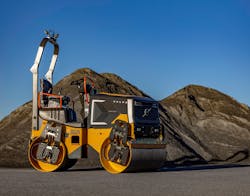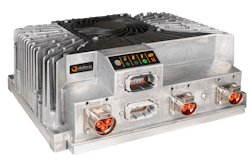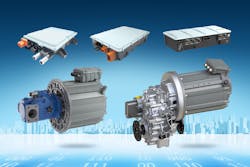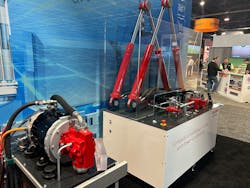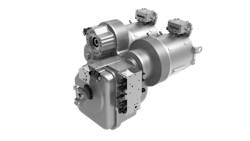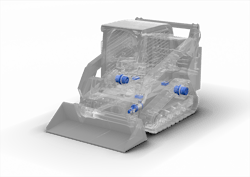Construction Equipment Digs Deeper into Electrification
The construction equipment industry’s continued push toward electrification was evident throughout CONEXPO-CON/AGG and co-located International Fluid Power Exposition (IFPE). While development of electric-powered machines and the necessary components has increased in recent years, the 2023 show demonstrated just how far technology has advanced since the last show 3 years prior.
Visit our IFPE channel for more news, video interviews and more related to the year's largest event for the fluid power and construction equipment industries.
OEMs and component manufacturers alike exhibited electrification related products, with many debuting new solutions at the show. Volvo Construction Equipment (Volvo CE), for instance, announced prior to CONEXPO & IFPE its plan to debut two new electric machines, a short swing radius mini excavator and conventional swing small excavator. It also exhibited its first electrified mid-range excavator, demonstrating the company’s growing lineup of electric-powered machines.
Volvo CE currently offers five electrified machines commercially and will make the two new smaller machines available in 2023. The mid-range excavator is planned to be available in 2024.
While smaller machines are currently the more feasible use case for electrification, the applications and machine sizes in which it can be deployed is increasing.
A Shift Toward Larger Heavy Equipment Applications
About 5 years ago, Delta-Q Technologies saw a shift in the construction equipment industry – as well as material handling, agriculture and other mobile applications – toward implementation of electrification on bigger machines. This shift required more power and faster on-board chargers said Mourad Chergui, Senior Product Manager at Delta-Q, during an interview with Power & Motion at IFPE 2023.
As such, the company began developing its 3.3 kW battery charger which it debuted at the show. The charger can be used in parallel with multiple chargers to achieve up to 10 kW, benefitting use in larger machines. In addition, the XV3300 includes a DC/DC converter to help power auxiliary loads, such as lights and heaters, as well as an electric vehicle (EV) charging station interface to make it easier for machine owners to utilize standard charging stations already available in the marketplace.
Chergui said now is the best time to be in the electrification market. “We are seeing tremendous growth across several industry segments,” he said, and that the company’s XV3300 is hitting the market at the right time due to demand it sees for the product in several global markets as electrification continues to grow.
Construction equipment in particular is experiencing a high rate of growth, as well as agricultural machinery he said. Chergui sees the material handling segment as one which is quite mature at this stage with its transition to electrification.
Electrification of machinery in these and other industries is being driven in large part by global emissions regulations which are expected to become more strict and widespread in the coming years. Also driving the move to electrified machinery is customers’ desire to be more sustainable. Projects contractors may be bidding on could have stipulations which require use of more environmentally friendly equipment as well.
WATCH MORE: 3 Drivers of Off-Highway Electrification
The additional benefits of electric-powered machines is also helping drive the market, such as their lower operating costs and reduced maintenance. Given construction equipment is used for business purposes the majority of the time, and the costs associated with owning and operating these machines, being able to provide a business case for moving to electric machines will aid their uptake.
Additionally, their lower noise and lack of emissions expands the applications in which these machines can be utilized. Both aspects benefit use indoors as well as city centers and overnight work.
Hydraulics and Pneumatics Expands into Electrification
The components within a machine play a key role in enabling electrification of construction equipment. Because of this, many manufacturers within the fluid power industry have diversified their product portfolios to include components for electric-powered machines. Not only does this enable them to stay relevant in an evolving industry but also help OEMs create optimized machines as changes to the hydraulics and pneumatics will be necessary with the move to electrification.
It was evident at IFPE 2023 just how much of an impact electrification is having on the fluid power sector with a large number of manufacturers displaying technology to aid with this trend as well as discussing how their expertise can help to assure all fluid power and electric systems will work appropriately with one another.
Bosch Rexroth, for instance, discussed its eLION portfolio of electrification products designed specifically for off-highway equipment during its press conference at IFPE. Most recently the company has added a single-phase onboard charger for compatibility with North American charging infrastructure.
Peter Dschida, Senior Vice President – Sales at Bosch Rexroth, said during the press conference that the mobile equipment industry is transforming, and everyone is talking about carbon neutrality. He said the challenge currently for OEM customers is determining which direction to go to achieve zero emissions performance in their machines – hydrogen, battery-electric or a combination of both.
Because of this, Dschida said OEMs are having to extend their knowledge and technological capabilities as do component suppliers like Bosch Rexroth.
With the move to electrification – and greater concern for fuel efficiency in diesel-driven machines – improved efficiency of hydraulic and other components is becoming increasingly critical. As such, several manufacturers demonstrated at IFPE the increased use of sensors and software to improve flow and pressure control of hydraulic components, leading to efficiency gains.
Parker Hannifin highlighted its SMART Electrification products which include hydraulic and electric components to provide heavy equipment manufacturers with complete system solutions. The availability of electronic control for the hydraulic components in this portfolio offers improved control and thus efficiency to aid the performance of electrified construction equipment.
Included in Parker Hannifin’s electrification portfolio, and displayed at IFPE, is an electric power take-off, or ePTO. Consisting of an electric motor, inverter or motor controller and a hydraulic pump powered by a DC power source, such as a battery, the ePTO enables hydraulic work functions to be powered by a machine’s battery instead of an engine. It can be utilized in battery-electric or engine powered equipment and enables the electrification of work functions to reduce emissions, noise and fuel consumption.
Noise is a major factor which needs to be considered with electric machines as well. While they tend to operate more quietly when the engine is replaced by a battery-electric power system, noises made by other components, such as the hydraulics, can become more audible.
To help overcome this, Bucher Hydraulics has developed the Smart PowerPack S (SPP S), an intelligent electrified power unit. It features an electronically controlled variable pressure-balanced hydraulic pump, a single power input connection, and an integrated Negative Bypass Control cartridge valve. It is designed to provide a small, power-on-demand system which can easily plug into a range of machine types and replace engine powered systems.
Doing so not only allows the electrification of hydraulic systems but also helps to reduce noise levels on job sites. Inclusion of the company’s AX pump in the SPP S enables quieter operation as it is able to operate almost silently as well as efficiently. The pump has 24 pistons which help to keep pulsations, and thus noise levels, at a low volume.
Motion Control and Power Transmission Solutions Aid Transition to Electric Power
Although IFPE has a large focus on hydraulic and pneumatic technologies, it also provides a showcase for other motion control and power transmission solutions which are just as vital to the operation of construction equipment. Advancements in these product categories, shown at IFPE and throughout the CONEXPO portions of the event, are enabling the electrification of heavy machinery as well.
Schaeffler, for example, displayed its electric motor technology which it describes as an e-machine because it can be used as a traction motor or a generator. It uses permanent magnet technology which enables the highest levels of efficiency.
Enhancements to the company’s manufacturing capabilities enabled it to not only develop the electric motor in house but also allow customization to meet OEM customer requirements. The axial length and windings of the motor can be adjusted as necessary to provide desired performance.
Moog Construction, part of Moog Inc., launched its TerraTech ecosystem of components which will help compact construction equipment manufacturers quickly develop all-electric machines. The portfolio includes motion control software, hardware such as electric cylinders and vehicle control modules, energy and battery management, and digital insights through the Internet of Things (IoT).
TerraTech is a fully integrated system solution that can help OEMs develop electric machines in as short as 6 months. Providing a full system like this ensures all of the components will work as required with one another and perform as desired; it also eases component sourcing by providing OEMs with a single supplier from which to get necessary technology.
The system can work on a range of machines, some of which have already been demonstrated in the market. Doosan Bobcat’s all-electric T7X compact track loader uses elements of the system; the company also unveiled at CONEXPO its S7X all-electric skid steel loader which incorporates TerraTech technology as well. Moog also collaborated with Komatsu on a full-electric compact wheel loader concept featuring this system which allowed the companies to quickly develop the machine and begin testing of it.
In addition to aiding electrification of machines, the TerraTech system enables digital insights into machine performance as well as make it easy to add updates or new features. It also prepares machines for incorporation of future technologies such as automation. Bobcat demonstrated this capability with the unveiling of its RogueX autonomous concept compact track loader at CONEXPO which is equipped with the TerraTech system.
READ MORE from Construction Equipment, an Endeavor Business Media partner site, about Bobcat’s new machines unveiled at CONEXPO:
Bobcat Unveils Electric Skid Steer Loader
Bobcat RogueX CTL Teases Autonomy
Dana Inc. has developed several driveline and other technologies for electric machines in recent years. At CONEXPO, the company unveiled its eSP502 e-Transmission featuring a dual-motor, two-speed design built on a flexible platform to optimize performance and efficiency in a compact package. It is designed to perform like a conventional powershift transmission, ensuring machine performance with which operators will be familiar.
Next generation control software and functional safety readiness helps to facilitate installation and integration for OEMs, ensuring the e-Transmission will work as required while meeting safety standards where necessary.
The e-Transmission and other electrification components are available as part of a full system solution. Dana noted this capability can be seen in the e-propulsion system it is providing to Wacker Neuson for use in Kramer branded electric machines which include a wheel loader and telehandler. An e-Transmission, motor and inverter, controller and energy management software are included as part of the e-propulsion system and help to ensure optimized machine performance.
Rapid Growth Ahead for Electric Construction Equipment
Chergui concluded the conversation at IFPE by noting that Delta-Q is seeing a high level of customer growth in the area of electrification around the globe, such as in Asia and Europe. But in North America the company is also witnessing many companies embarking on their electrification journeys.
He said Delta-Q estimates electrification will be more mainstream in the heavy-duty equipment markets by 2025, and that by 2035 a large share of machines, possibly as much as 50% or more, will be electrified.
With this will come electrification of larger machines as well as higher voltages. Today, 48 and 96V are common but there already have been steps toward 400 and 800V to provide the power necessary for larger machines.
Dschida said during Bosch Rexroth’s press conference that over the next 5-8 years it is unclear which machine functions will still be hydraulic and which electric. He says a small volume of machines may go full-electric, i.e. there will be no hydraulics, while the majority will feature a combination of electric and hydraulic.
This is why Bosch Rexroth and other component manufacturers are designing their technologies to be flexible and modular – enabling them to meet the varied needs of OEM customers in the coming years.
How OEMs and component suppliers go about achieving their electrification goals – whether that be full-electric, hybrid, fuel cells or other methods – remains to be seen. But it is clear the value the construction equipment industry foresees in going electric and how it can benefit customers as well as the environment.
READ MORE - The Road to Zero: Utilizing Electrification to Unlock New System Architectures
About the Author
Sara Jensen
Executive Editor, Power & Motion
Sara Jensen is executive editor of Power & Motion, directing expanded coverage into the modern fluid power space, as well as mechatronic and smart technologies. She has over 15 years of publishing experience. Prior to Power & Motion she spent 11 years with a trade publication for engineers of heavy-duty equipment, the last 3 of which were as the editor and brand lead. Over the course of her time in the B2B industry, Sara has gained an extensive knowledge of various heavy-duty equipment industries — including construction, agriculture, mining and on-road trucks —along with the systems and market trends which impact them such as fluid power and electronic motion control technologies.
You can follow Sara and Power & Motion via the following social media handles:
X (formerly Twitter): @TechnlgyEditor and @PowerMotionTech
LinkedIn: @SaraJensen and @Power&Motion
Facebook: @PowerMotionTech

Leaders relevant to this article:

